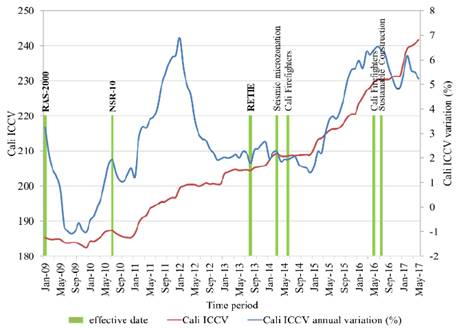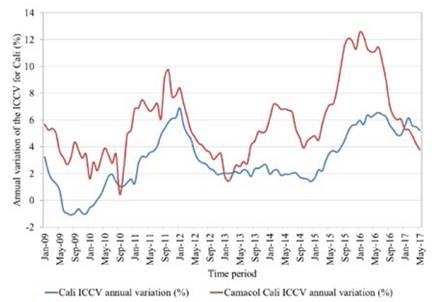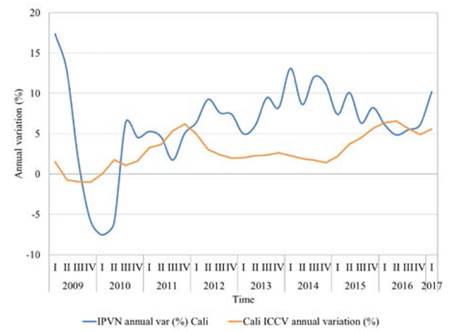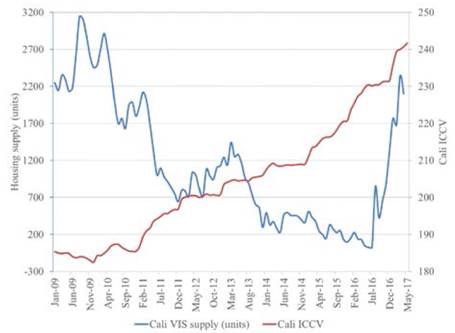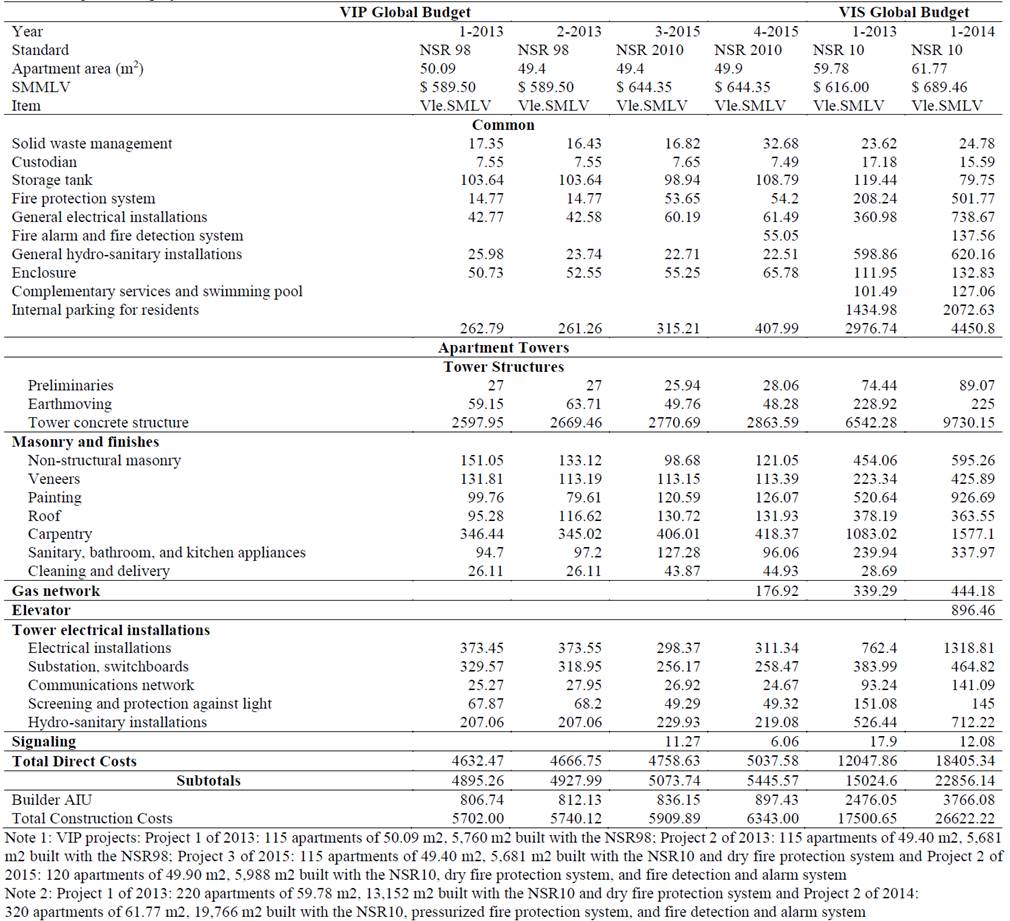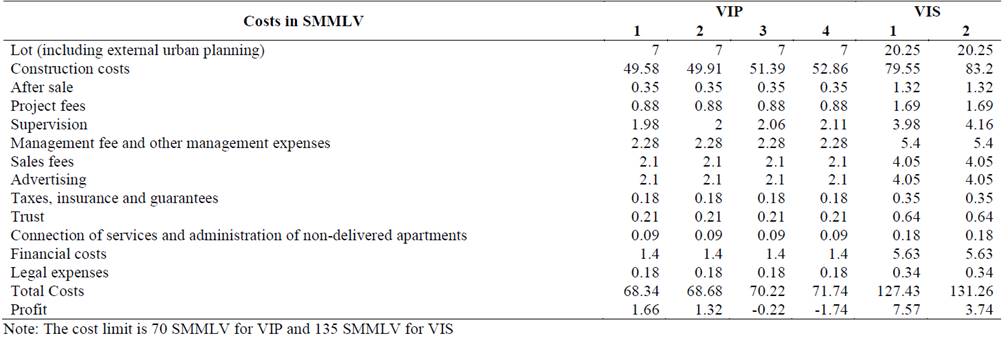1. INTRODUCTION
The obligation to comply with Article 51 of the Constitution of Colombia-“All Colombians have the right to a decent housing” [1]-makes it such that this right in Colombia is specifically one of the paths with which the State seeks to guarantee the quality of life of the population. This fact explains the existence of social and priority housing programs to provide housing solutions to low-income households [2].
Currently, private builders are generally responsible for the construction of social interest housing (VIS, in Spanish) and priority interest housing (VIP, in Spanish) [3] for amounts that should not exceed 135 times the statutory monthly minimum wage (SMMLV, in Spanish) and 70 times the SMMLV, respectively [4]. Moreover, from the perspective of the State, technical and economic guidelines that govern the construction of these projects are being defined [5], sometimes offering conditions that go beyond economic policies and technical aspects [6].
Currently, construction regulations have arisen in addition to the Colombian Regulation of Earthquake Resistant Construction (NSR-10), including the Technical Regulation of Electrical Installations (RETIE, in Spanish), Technical Regulation of the Drinking Water and Basic Sanitation Sector (RAS-2000), Parameters and Technical Guidelines for Sustainable Construction - Guide for Water and Energy Saving in Buildings, Safe Housing Law, Technical Regulation for Internal Telecommunication Networks (RITEL, in Spanish), Administrative, Operational, Technical and Academic Regulations of Firefighters of Colombia and, in the case of Cali, Earthquake Microzoning of Santiago de Cali. All these technical regulations are generating construction cost overruns and therefore have an impact on the square-meter increase to the final consumer.
Since the VIS and VIP prices are based on the SMMLV, the only increment that is reflected year after year is the annual increase in the statutory monthly minimum wage, for which the builder must build within the established price range, including the mandatory technical provisions for this type of housing, despite the costs entailed.
This research analyzes the impact on direct costs per constructed square-meter that involves the implementation of the new technical criteria of the Colombian Regulation of Earthquake Resistant Construction (NSR-10) in relation to fire protection networks and fire detection equipment, gas networks, and communication networks, which affect the square-meter increase to the final consumer. The study was based on the analysis of detailed technical and budgetary information of four social interest housing projects and two priority interest housing projects, which were designed and built from 2010 onward and were based on technical regulations in force at the time of approval and start of construction.
1.1. Problem statement
Colombia has numerous laws, decrees, resolutions and technical standards issued by multiple state or autonomous entities that mandate or regulate technical aspects of mandatory compliance in the construction of buildings. These regulations, which includes structural design aspects (NSR-10), electrical installations (RETIE, in Spanish), telecommunications (RITEL, in Spanish), hydro-sanitary (RAS2000), and fire protection systems and human safety (Firefighters), among others, are in a process of continuous adjustment, updating or coming into force. In addition, other requirements related to safety, occupational health and the environment are also incorporated in construction projects and demand training and certified personnel for working at heights and handling sector-specific tools.
Even though the introduction of some of these standards has been progressive, it is evident that, to a greater or lesser extent, their application affects the direct construction costs of VIS and VIP projects, either because they affect design parameters, increase the requirements of specifications or include new conditions that did not previously exist and are to apply from the implementation date of the standard. This affects the quality of the delivered housing by decreasing the usable area and eliminating finishes.
2. SOCIAL INTEREST HOUSING IN LATIN AMERICA
The main referents regarding social interest housing in Latin America are in Chile, Brazil and Mexico. Particularly, the Chilean model has been incorporated by the Banco Interamericano de Desarrollo (Inter-American Development Bank) due to its tradition and evolution [7], and it is adapted for the Colombian case. Subsidies in Brazil are granted based on income, favoring people with lower incomes. Meanwhile, Chile grants subsidies according to family condition in terms of qualifications such as for vulnerable, emerging and middle-income families, categorization according to which subsidies of US $18,500, US $20,000 and US $13,200 are granted, respectively.
Regarding Mexico, the maximum subsidy is US $4,900 and is granted to families with incomes under US $740. In the Colombian case, the subsidy is US $9,000 for displaced families, and in other cases for amounts of US $6,000. Table 1 summarizes the characteristics of different social housing programs, as previously discussed. The policy models of these countries are very similar and aim mainly to bring the housing supply closer to the economic possibilities of demand, using subsidies, savings and mortgage loans.
Table 1 Comparison of characteristics of social interest housing programs in Latin America.

Source: Taken and adapted from [7]
3. SOCIAL INTEREST HOUSING IN COLOMBIA
Throughout the history of Colombia, different programs have been developed to satisfy the need of housing to reach what today is known as social interest and priority interest housing. These changes are outlined in public and legislative policies as well as in regulatory decrees that included the creation of institutions such as the Banco Agrícola Hipotecario (Agricultural Mortgage Bank) (1926), Banco Central Hipotecario (Central Mortgage Bank, BCH in Spanish) (1932), and Instituto de Credito Territorial (Local Credit Institute, ICT in Spanish) (1939) [8]. Subsequently, other programs emerged for financing low-income housing (1946), housing subsidies (1954) and systems of raising funds through private savings with figures such as the UPAC (Units of Constant Purchasing Power, UPAC in Spanish) (1972), until reaching the national system of social interest housing that emerged between 1989 and 2000. Later, between 2006 and 2010 the Friendly Housing (Vivienda Amable) Policy was implemented through the “Friendly Cities and Housing” Plan, the Plan to Promote Productivity and Employment (PIPE, in Spanish), which attempted to stimulate the economic activity in the short and medium term through the priority interest housing program for people with savings, and the expansion of coverage to the interest rate for mortgage loans or housing leasing contracts for the acquisition of new homes between 135 and 335 SMMLV [9].
3.1. Quality of social interest housing in Colombia
In the guide “Quality of social interest housing”, the following attributes are established for the quality concept: population factors for the formulation of the project, quality parameters at the moment of selecting the land, determinants for the formulation of the urban design and determinants for the formulation of the architectural design [10]. However, according to the Information Brochure No. 21, “the human right to adequate housing”, from the High Commissioner office for Human Rights of the UN, the minimum criteria for adequate housing are tenure security, availability of services, materials, facilities and infrastructure, affordability, habitability, accessibility, location and cultural adequacy.
Taking into consideration the previous referents, it was proposed in Colombia that the new housing should have adequate sleeping area, clothing closets, personal hygiene and laundry and allow for the storage, washing, preparing, and consumption of food; however, no minimum requirements for quality finishes were mentioned for decent habitability conditions of the completed spaces.
Minimum dimensions for interior spaces were considered, which vary according to their type. In the case of bedrooms, the minimum width is 2.70 m, and when building the bedroom with the minimum dimensions, there is only space for a double bed, a walkway, a nightstand and the opening of the door, and in the case of a single bed, there is space to build a closet.
As mentioned, currently the living units are delivered with minimal areas, with partial finishes or without, which generate comfort and hygiene issues for a decent lifestyle.
4. METHODOLOGY
For developing the research, the market indicators and the evolution of costs and prices were reviewed as follows:
Review of housing cost indices in Cali according to reports from the Departamento Administrativo de Estadística (Administrative Department of Statistics, DANE in Spanish) and the Cámara Colombiana de Comercio (Colombian Chamber of Construction, CAMACOL in Spanish) and the database of prices and yields from Construdata;
Revision of Laws, Decrees and Standards that regulate the construction of social interest housing; and
Cost comparison of six specific cases of VIS and VIP projects executed by a company in the sector between 2010 and 2015.
5. ANALYSIS OF MARKET INDICATORS AND EVOLUTION OF COSTS AND PRICES FOR VIS AND VIP PROJECTS
The following indicators were analyzed in this case study: Construction Cost Index for Housing (ICCV, in Spanish) by DANE, Construction Cost Index for Housing by CAMACOL, Construction Cost Index by Construdata, New Housing Price Index (IPVN, in Spanish) by DANE, Basic Report of Urban Location by CAMACOL, Supply and Demand Study for Housing in Cali by CAMACOL and Building Census (CEED, in Spanish) by DANE.
5.1. Construction cost index for housing (ICCV, in spanish) by DANE
“The ICCV shows the cost behavior of the main inputs used in the construction of housing” [11], and it shows the average cost for the construction of the residential unit as a result of changes in price for construction supplies (materials, labor, tools and equipment).
Its monthly percentage variation allows for variations in the construction cost over time. The compliance of the new constructive standards between 2009 and 2017 has led to the variation shown in Fig. 1 prepared with information from the Departamento Administrativo Nacional de Estadisticas (National Administrative Department of Statistics, DANE in Spanish). The greatest increases occurred with the introduction of the NSR-10, RETIE and Firefighters [12].
5.2. Construction Cost Index for Housing (ICCV, in Spanish) by CAMACOL
The Cámara Colombiana de la Construcción (Colombian Chamber of Construction) CAMACOL, Valle del Cauca chapter, publishes monthly Construction Cost Indices for different types of residential buildings in Cali. This report includes the price variation of construction materials for housing in relation to hydro-sanitary installations, internal and external electrical installations, telephone installations and public works. In this study, it was found that the variations between the CAMACOL ICCV and DANE ICCV have a similar trend, which allowed validating the actual behavior of the construction cost, evidencing periods of greater increases after the introduction of the NSR-10 and fire protection regulations (Fig. 2).
5.3. Construction cost indices by Construdata
The construction costs for different projects and the evolution of costs as a whole can be consulted in the Construdata journal, which contains information on the main cities of the country [13]. For this study, related information for the city of Cali was taken from issue No. 156 (third quarter of 2010) to No. 183 (second quarter of 2017), and it was found that as of 2014, the date on which the guidelines for earthquake microzoning, fire brigades and sustainable constructions came into force, a cost increase has been maintained, which reflects a final cumulative cost of 16.31%.
5.4. New housing price index (IPVN, in spanish) by DANE
The New Housing Price Index-IPVN-is a quarterly statistical report that presents the real dynamics of the market prices [14]. If the behavior of the ICCV is compared with the IPVN, the behavior follows the variation of the ICCV, where the trends in variations of the ICCV are reflected in the IPVN later on (Fig. 3).
6. Considerations in relation to supply and demand
According to the CAMACOL reports between 2012 and 2013, there was a decrease in the effective housing demand from 22.80% to 13.79%, which could infer that this happened because some users had access to the “Free Housing” program [15]; nevertheless, it is evident that the housing demand was increasing throughout the period analyzed for the city of Cali. Table 2 summarizes the housing demand for the city of Cali.
Currently, if the construction ICCV is compared to the housing supply, a decrease in housing supply is observed, a situation that is related to the cost increase generated by the inclusion of the new standards; however, between May 2016 and May 2017, the increase in supply coincided with Government initiatives to provide Colombian families with housing solutions. Fig. 4 shows the housing supply in Cali and the impact of the ICCV.
7. CONSIDERATIONS REGARDING REGULATIONS AND THEIR IMPACT ON COSTS
Law 1537 of June 20, 2012, establishes “regulations intending to facilitate and promote urban development and access to housing and other provisions” related to financing social interest housing in Colombia. The Colombian State mainly promotes the construction of social interest and priority interest housing through a subsidies policy. Additionally, local entities may concur in the financial contribution of those projects.
Today, there is a limit on the acquisition value for social interest housing of one hundred thirty-five times the statutory monthly minimum wage (135 SMMLV), and seventy times the statutory monthly minimum wage (70 SMMLV) for priority interest housing, values that incorporate the costs of the real estate market for project development and that include land costs, architectural and engineering fees, urbanization and public services, direct construction costs, indirect costs, financial costs and revenue [16].
7.1. Standards analysis
The regulations and technical standards that directly affect the construction of social interest and priority interest housing in Colombia are now summarized.
7.1.1. Colombian regulation of earthquake resistant construction, NSR-10
This regulation establishes the criteria and minimum requirements for the design, construction and technical supervision of new buildings. Legally, it is supported by Law 400 of 1997 [17], which was initially regulated by Decree 33 of 1998 [18] and later by Decree 926 of 2010 [19], which adopted the Colombian Regulation of Earthquake Resistant Construction NSR-10. That regulation has been modified by Decrees 2525 of July 13, 2010, and Decree 340 of February 13, 2012. It is currently evaluating a new project for the modification of Titles J and K [20].
7.1.2. Technical regulation of electrical installations, RETIE (in spanish)
This regulation standardized the construction, maintenance and operation of the electrical service in Colombia, is legally supported by Law 143 of 1994 [21] and was adopted by Resolution 90708 of 2013 [22]. For the particular issue of social interest and priority interest housing projects, the minimum electrical circuitry and products that buildings must have, technical construction conditions, evaluation and certifications were defined.
7.1.3. Technical regulation of the drinking water and basic sanitation sector, RAS-2000
This regulation specified the mandatory requirements for building sites, equipment and operating procedures that are used in public services of plumbing, sewers, cleaning and their related activities. It was adopted by Resolution 1096 of November 17, 2000 [23], in compliance with the provisions of Law 142 of 1994 [24], which establishes the system of Public Services in Colombia and seeks to guarantee its quality at all levels. In 2009, the “Technical Regulation of plumbing and sewer pipelines” began, which includes the use of equipment, systems and implements of low water consumption in accordance with Decree 3102 of December 30, 1997.
7.1.4. Parameters and technical guidelines for sustainable construction - Guide for water and energy savings in buildings
This standard was issued through Resolution 549 of 2015 [4] and became effective as of July 10, 2016. It establishes the parameters and technical guidelines related to the efficient use of water and energy in new buildings. Due to its recent implementation, there is no clarity regarding the impact on the direct costs of social interest and priority interest housing.
7.1.5. Safe housing law
This regulation was issued through Law 1796 of July 13, 2016 (Ministry of Housing, City and Territory, 2015), by which measures are established focusing on protection of the home buyer, increases in building security and strengthening the public function exercised by City Planners. Certain functions are assigned to the Superintendence of Notaries and Registry, and other provisions are enacted. It came into effect as of July 13, 2016. It mandates that all buildings without exception require a structural inspection by a City Planner or by district or municipal offices [25]; however, in the case of VIS, due to the relatively small footprints of their buildings, only the structural inspection and technical supervision for buildings of 2,000 square meters or greater are required. Due to its recent implementation, there is no clarity regarding the impact on the direct costs of social interest and priority interest housing.
7.1.6. Technical regulations for internal telecommunication networks, RITEL (in spanish)
This regulation established measures related to the design, construction and commissioning of internal telecommunication networks in Colombia. Legally, it is supported by Law 1341 of 2009, which defined the principles and concepts on social information, and the organization of Information and Communication Technologies (TIC, in Spanish) [26]. It is adopted by Resolution No. 4262 of 2013 [27].
The RITEL has undergone several modifications and adjustments, and although it does not refer in particular to social interest housing, it categorizes according to the area and stratum of the living unit, design of the minimum grid connection, distribution network and dispersion network of each unit. Its application was suspended by the Communications Regulation Commission (CRC) of Colombia until September 8, 2017 [28], and due to its high incurred costs, a possible definitive suspension is speculated.
7.1.8. Earthquake microzoning of Cali.
It was adopted by Decree 411.0.20.0158 of March 18, 2014 [32] and is supported in NSR-10 [17]. This regulation applies to all types of buildings to be constructed in Cali, including VIS and VIP. According to the earthquake spectrum zone where the project is located, cost overruns may arise due to the geotechnical quality of the soil.
7.2. Project analysis
For the analysis, projects meeting the following conditions were sought:
Those executed between 2010 and 2017;
Those within in the range of physical, technical and area characteristics for both VIS and VIP projects; and
Those for which complete technical and budgetary information is available.
7.2.1. The case of VIP projects
For the VIP case, the information for four projects was analyzed for the south-eastern zone of the city of Cali. The cost estimate in Table 3 was adjusted to the statutory monthly minimum wage on the construction date so the values could be compared.
7.2.2. The case of VIS projects
For the VIS case, the study was performed with available information from two projects carried out in the south-eastern zone of the city of Cali.The costs associated with the construction according to the standards are described in Table 4.
8. DISCUSSION
Regarding the cost structure, it is evident that the requirement to comply with the fire-prevention network and the fire detection and alarm systems by including electrical installations in common areas and solid waste management are impacting the housing cost.
For priority interest housing, it was found that between 2013 and 2015, on average, the solid waste management cost went from 0.145 SMMLV per living unit (p.u.v., in Spanish) to 0.21 SMMLV / p.u.v. Similarly, the economic impact of the fire protection system indicates that on average for 2013, the cost p.u.v. was 0.13 SMMLV / p.u.v., compared to 0.46 SMMLV / p.u.v. in 2015, which on average increased the costs of this system. On the other hand, in relation to general electrical installations, the cost increased to 0.515 SMMLV / p.u.v. in 2015 from 0.37 SMMLV / p.u.v., which was the average cost of those facilities in 2013.
Fire detection systems were not required in 2013, and their inclusion in 2015 incurred a cost of 0.46 SMMLV / p.u.v.
9. CONCLUSIONS
Housing is one of the basic needs of every human being. In the case of Colombia, the State has proposed different initiatives that allow the low-income population to access housing through social interest and priority interest housing programs. In addition to the Colombian Regulation of Earthquake Resistant Construction NSR-10, new technical standards have been incorporated to guarantee a better quality of the housing that is being built; constructive provisions, despite being necessary, are affecting the ceilings that the Government has established for the construction of VIS and VIP. The study revealed that with the implementation of the Technical Regulation of Electrical Installations (RETIE, in Spanish), the costs have increased up to 6.56%. This study should continue in order to incorporate the economic impacts that result from the implementation of the Technical Regulations of the Drinking Water and Basic Sanitation Sector - RAS-2000, Parameters and Technical Guidelines for Sustainable Construction, provisions that derive from the Safe Housing Law, Technical
Regulation for Internal Telecommunication Networks (RITEL, in Spanish), Administrative, Operational, Technical and Academic Regulations of the Firefighters of Colombia, among others. The results obtained from an economic analysis that incorporates the compliance of those standards can help to support a cost structure that allows the builder to assist the Government with initiatives to serve the unmet housing demand for Colombians.













